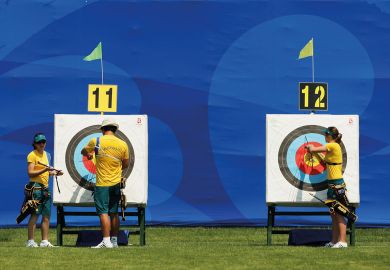Education is a cornerstone of Australia’s first “national well-being framework”, a federal government initiative to gauge whether economic progress is paying off socially – and vice versa.
A new report, Measuring What Matters, tracks progress on 49 indicators, from life expectancy, homelessness and chronic illness to air quality, job satisfaction, social connections, trust in government and prominence of indigenous languages.
The framework uses seven education and training metrics to assess whether Australians have “broad opportunities” for secure and well-paid employment. The report notes progress in post-school education and training attainment over the past decade: between 2013 and 2022, the proportion of 25- to 34-year-olds with degrees, trade qualifications, diplomas or advanced vocational certificates rose from 66 to 73 per cent.
The framework also tracks education’s interplay with other domains. Education plays a role in buttressing health, the report notes, while “creative and cultural engagement” helps support educational outcomes.
Treasurer Jim Chalmers said the new approach would help in “better aligning our economic and social goals in our communities and right across the country”. It is intended to complement rather than replace traditional economic measures like gross domestic product, employment, inflation and wages.
The exercise reflects longstanding overseas efforts to move beyond purely financial metrics. Work to create the Canadian Index of Wellbeing began in 1999, while New Zealand produced the first iteration of its Living Standards Framework in 2011. In Europe, a process that spawned the “Wellbeing in Germany – what matters to us” initiative began in 2013.
Similarly, Australia’s framework is framed as just the start of an “iterative” process. The report says that the education indicators will “evolve” to include targets being developed by three current reviews, including the Universities Accord.
The accord’s interim report, released on 19 July, says Australia has comfortably exceeded last decade’s target for 40 per cent of young adults to have degrees. But success has been patchy, with Queensland and Tasmania still lagging.
Speaking in the Accord Insights webinar the day after her report’s release, chair Mary O’Kane promised a “strong emphasis on targets” in her panel’s final report in December. This would include “big targets for the overall numbers” and goals for under-represented groups, including in postgraduate study.
The interim report flags separate targets for indigenous people, regional Australians, socio-economically disadvantaged students and people with disabilities to achieve “parity” by 2035. Long-term targets could be supported by “short-term step-change” targets disaggregated at state, region and provider level.
More broadly, the interim accord report hints at a 55 per cent degree attainment target by 2050, up from almost 45 per cent among today’s young adults. This would require “at least” 1.2 million government-supported students by 2035 and 1.8 million by 2050, it says. Current policy settings and demographic patterns will produce just 1.2 million students by 2050, it warns.
Register to continue
Why register?
- Registration is free and only takes a moment
- Once registered, you can read 3 articles a month
- Sign up for our newsletter
Subscribe
Or subscribe for unlimited access to:
- Unlimited access to news, views, insights & reviews
- Digital editions
- Digital access to THE’s university and college rankings analysis
Already registered or a current subscriber?








